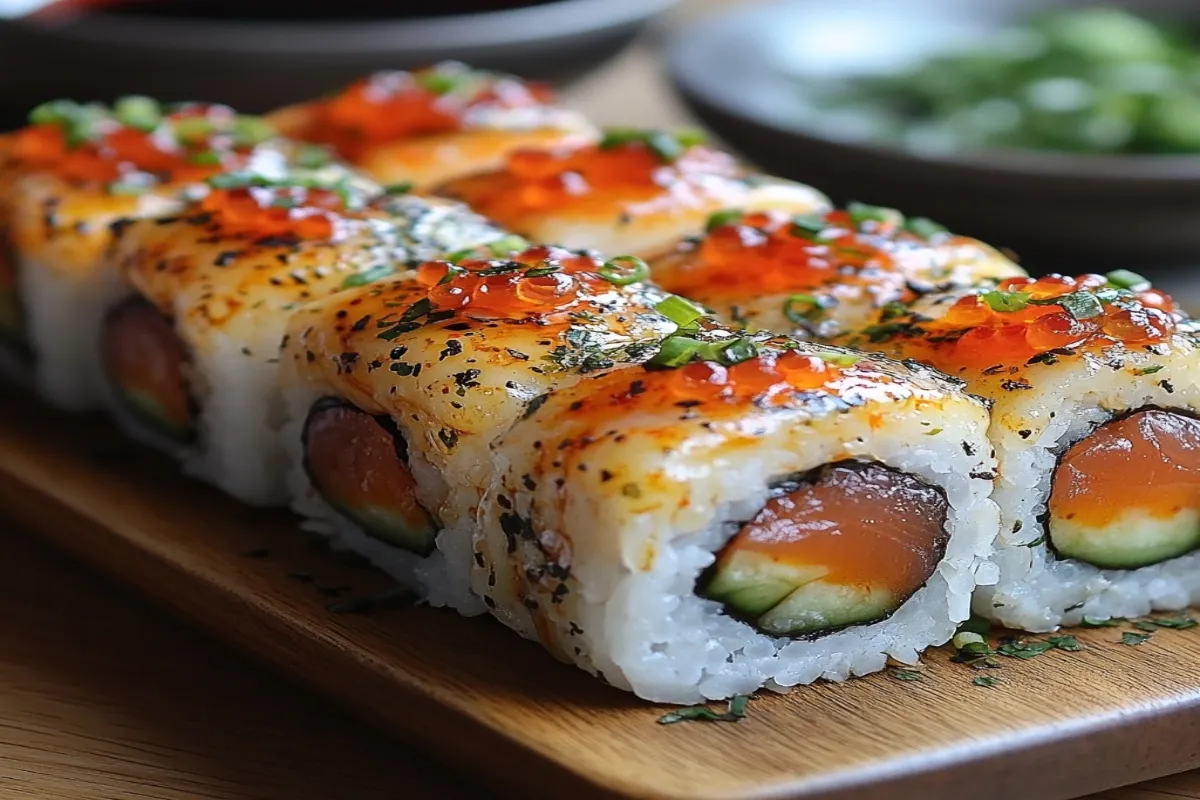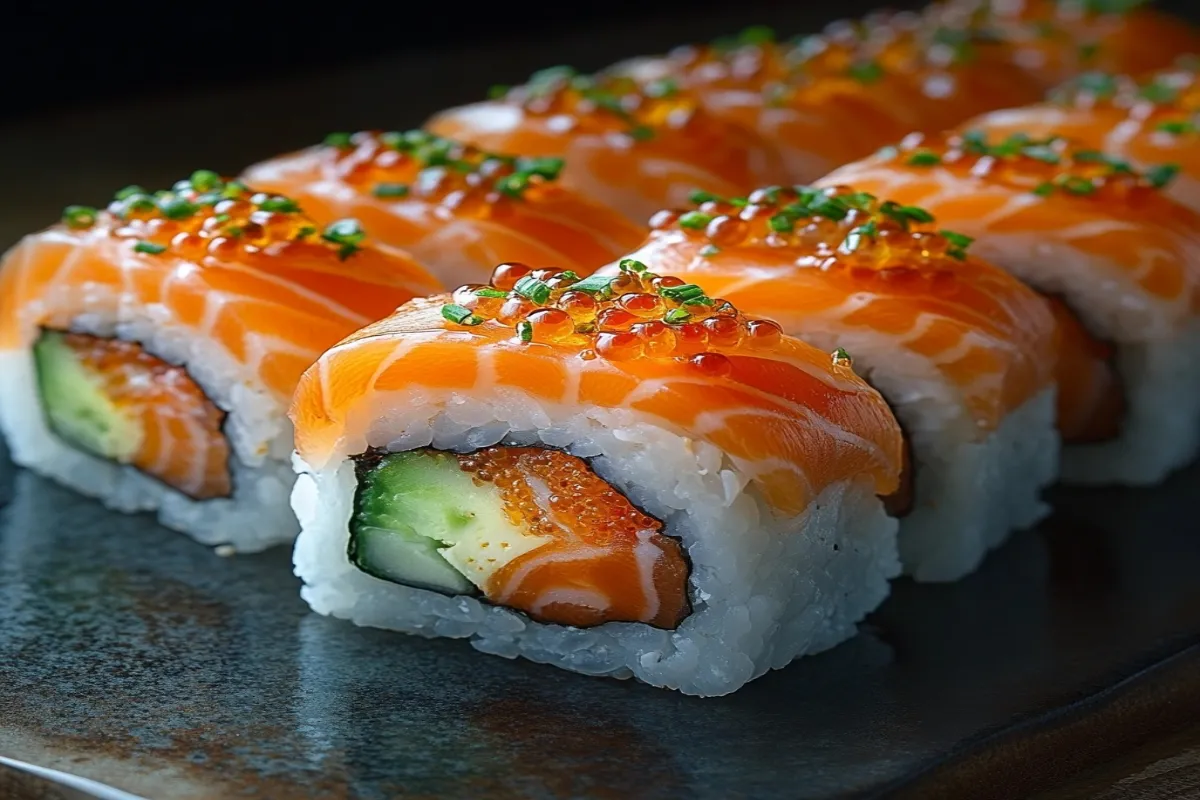Introduction
When it comes to sushi, we often think of delicate slices of raw fish and beautifully crafted rolls. However, there’s a whole world of vegetarian sushi options that are just as flavorful and satisfying. One such option is the Oshinko roll—a delightful, crunchy, and colorful sushi roll featuring Japanese pickled radish, known as Oshinko. This vibrant yellow pickle not only adds a splash of color to your sushi platter but also brings a refreshingly tangy and slightly sweet flavor, making it a perfect choice for those who prefer a vegetarian option or simply want to try something new.
The beauty of the Oshinko roll lies in its simplicity. It’s made with just a few ingredients, but it packs a punch of flavor and texture that will keep you coming back for more. Traditionally, this roll features crunchy pickled daikon radish wrapped in sushi rice and nori (seaweed), creating a harmonious balance of savory, sweet, and slightly salty tastes.
In this article, we’ll take you through the entire process of making an Oshinko roll, from the key ingredients to step-by-step preparation instructions. We’ll also explore tips for perfecting the roll, discuss how to serve it attractively, and suggest some variations and dietary adaptations for those looking to add their own twist. Whether you’re new to sushi making or a seasoned pro, this guide will provide all the details you need to create a delicious and visually stunning Oshinko roll in your own kitchen.
Key Ingredients for an Oshinko Roll
The key to a delicious Oshinko roll lies in its simple yet high-quality ingredients. Here’s a breakdown of what you’ll need and why each component plays a crucial role in making this sushi dish truly shine.
1. Oshinko (Pickled Daikon Radish)
The star ingredient of this sushi roll is, of course, the Oshinko, which is a Japanese pickled daikon radish. This bright yellow radish offers a unique combination of crunch, sweetness, and a slight tanginess. Its distinct flavor profile balances beautifully with the rice and nori, making it a standout component. Oshinko is available at most Asian grocery stores, but you can also pickle your own daikon radish at home if you’re feeling adventurous.
- Substitution: If you can’t find Oshinko, you can substitute it with other pickled vegetables such as pickled cucumbers or carrots. Keep in mind that these alternatives will change the flavor slightly, but they will still provide the necessary crunch and brightness.
2. Sushi Rice (Short-Grain Rice)
Sushi rice, or shari, is the foundation of any sushi roll. It’s a sticky, slightly sweet rice that holds the roll together. The rice is seasoned with a mixture of rice vinegar, sugar, and salt, giving it that signature tangy taste. Getting the rice right is essential for achieving the perfect texture in your Oshinko roll.
- Substitution: If you’re looking for a lower-carb alternative, you can use quinoa or cauliflower rice. These substitutes won’t have the same sticky texture but will offer a lighter option.
3. Nori (Seaweed Sheets)
Nori is the thin, dried seaweed sheet that wraps around the sushi roll, holding it all together. It adds a salty, umami flavor and a bit of crunch when toasted. Without nori, the roll wouldn’t have that signature sushi look and taste.
- Substitution: If you’re not a fan of nori or are allergic to seaweed, you can use thin slices of cucumber as a wrapper for a fresh twist.
4. Rice Vinegar
Rice vinegar is used to season the sushi rice, giving it the signature tang that complements the pickled radish. It’s mild and slightly sweet, making it ideal for sushi.
- Substitution: Apple cider vinegar can be used in place of rice vinegar, but be sure to adjust the amount to maintain the right balance of acidity.
5. Sugar and Salt
These two ingredients are mixed with the rice vinegar to season the sushi rice. They enhance the flavor of the rice without overpowering the other ingredients.
- Substitution: If you’re avoiding sugar, a natural sweetener like honey or agave syrup can work, but use it sparingly to avoid making the rice too sweet.
6. Soy Sauce
Soy sauce is often served on the side for dipping. It adds a salty umami note that enhances the flavors of the Oshinko roll.
- Substitution: For a gluten-free option, tamari is a great alternative to soy sauce.
7. Wasabi and Pickled Ginger (Optional)
These traditional sushi accompaniments are not necessary for the roll itself but can be served alongside for added heat (wasabi) and a palate cleanser (pickled ginger).
How to Make an Oshinko Roll

Now that we have all the ingredients ready, it’s time to roll up our sleeves and make this delicious sushi dish! Don’t worry if you’re new to sushi making—this step-by-step guide will walk you through the entire process, ensuring you end up with perfect Oshinko rolls every time.
1: Prepare the Sushi Rice
The first and most crucial step in making an Oshinko roll is preparing the sushi rice.
- Rinse the Rice: Start by rinsing 2 cups of short-grain sushi rice under cold water until the water runs clear. This step removes excess starch and prevents the rice from becoming too sticky.
- Cook the Rice: Cook the rice according to the package instructions or using a rice cooker. Once done, transfer it to a large bowl and let it cool slightly.
- Season the Rice: In a small saucepan, heat 1/4 cup of rice vinegar, 2 tablespoons of sugar, and 1 teaspoon of salt until dissolved. Pour this mixture over the warm rice and gently fold it in, being careful not to mash the grains. Let the rice cool to room temperature.
2: Prepare the Oshinko
While the rice cools, it’s time to get the Oshinko ready.
- Slice the Oshinko: If you’ve bought pre-pickled Oshinko, slice the daikon radish into long, thin strips (about the length of the nori sheet). If you’re pickling your own, be sure to give it enough time to develop its flavor, typically 24 hours.
3: Set Up Your Sushi Rolling Station
To roll the sushi, you’ll need a bamboo sushi mat (makisu) wrapped in plastic wrap to prevent sticking. Lay it flat on a clean surface.
4: Assemble the Oshinko Roll
- Place the Nori Sheet: Place one sheet of nori, shiny side down, on the bamboo mat.
- Add the Sushi Rice: Wet your hands to prevent the rice from sticking. Take about a handful of the seasoned sushi rice and spread it evenly over the nori, leaving a 1-inch border at the top.
- Add the Oshinko: Place a strip or two of Oshinko horizontally across the center of the rice.
5: Roll the Sushi
- Start Rolling: Using the bamboo mat, carefully lift the edge closest to you and start rolling it over the filling, tucking it in as you go.
- Seal the Roll: Once the roll is complete, lightly moisten the top edge of the nori with water to seal it.
6: Slice and Serve
- Slice the Roll: Using a sharp knife, slice the roll into bite-sized pieces. To prevent sticking, dip the knife in water between cuts.
- Serve the Rolls: Arrange the Oshinko rolls on a serving platter and serve with soy sauce, wasabi, and pickled ginger.
Tips for Perfecting Your Oshinko Roll
Creating the perfect Oshinko roll takes some practice, but with these tips, you’ll be well on your way to sushi success.
1. Use Fresh Ingredients for the Best Oshinko Roll Sushi
The fresher your ingredients, the better your rolls will taste. Always use high-quality sushi rice and fresh nori for the best results. If possible, pick up your Oshinko from a trusted source or make your own at home.
2. Keep Your Hands Wet When Making Pickled Radish Sushi Rolls
When handling sushi rice, wet your hands frequently to prevent the rice from sticking to your fingers. This will make it much easier to spread the rice evenly over the nori.
3. Don’t Overfill Your Vegetarian Sushi Rolls
While it’s tempting to load up your roll with lots of filling, be careful not to overdo it. Overstuffing the roll can make it difficult to roll properly and may cause the nori to tear.
4. Use a Sharp Knife for Perfectly Sliced Oshinko Sushi Rolls
A sharp knife is essential for slicing your Oshinko rolls cleanly. Dull knives will crush the roll and ruin the presentation.
5. Experiment with Flavors in Your Oshinko Maki Sushi
While the traditional Oshinko roll is simple, feel free to add other ingredients like avocado, cucumber, or sesame seeds for extra texture and flavor.
Presentation and Serving Suggestions for Oshinko Sushi Rolls

When it comes to sushi, presentation is just as important as taste. Here’s how to present your Oshinko rolls beautifully and make them the star of your next meal.
1. Plating Techniques for Beautiful Oshinko Rolls
Arrange the Oshinko rolls neatly on a rectangular or circular sushi plate. To add a pop of color, consider sprinkling black or white sesame seeds on top of the rolls. You can also place a small mound of pickled ginger and a dollop of wasabi on the side for an authentic sushi restaurant feel.
2. Garnishing Your Pickled Radish Sushi Rolls for Extra Flavor
Fresh garnishes like thinly sliced cucumber, radish, or microgreens can add a touch of elegance to your presentation. A sprinkle of finely chopped green onions or cilantro can also brighten up the plate and complement the flavors of the roll.
3. Best Side Dishes for Vegetarian Oshinko Sushi Rolls
Pair your Oshinko rolls with light side dishes such as miso soup, edamame, or a simple seaweed salad. These dishes enhance the sushi experience without overpowering the delicate flavors of the rolls.
4. Drink Pairings for Your Oshinko Maki Sushi
For drinks, consider serving green tea, which provides a refreshing contrast to the tangy Oshinko. Alternatively, a sparkling water with a slice of lemon or lime can cleanse the palate between bites.
5. Occasion Adaptations for Serving Pickled Radish Sushi Rolls
The Oshinko roll is versatile enough to be served at a variety of occasions. For casual gatherings, serve the rolls on a large platter for easy sharing. For more formal events, you can plate individual portions with artistic garnishes and small dipping bowls of soy sauce.
Oshinko Roll Variations and Dietary Adaptations for Vegetarian Sushi Lovers
While the traditional Oshinko roll is delicious in its own right, there are several ways you can modify the recipe to suit different tastes and dietary needs.
1. Add More Vegetables
For a more colorful roll, consider adding other vegetables like julienned carrots, cucumber, or avocado. These ingredients not only add texture but also provide additional nutrients and visual appeal.
2. Gluten-Free Version
To make your Oshinko roll gluten-free, simply substitute the soy sauce with tamari. You can also check that the nori you’re using is certified gluten-free.
3. Vegan Options
The traditional Oshinko roll is already vegan, making it a great option for those following a plant-based diet. However, you can enhance the vegan experience by adding ingredients like marinated tofu or thinly sliced mushrooms for a meaty texture without using animal products.
4. Spicy Twist
If you enjoy a bit of heat in your sushi, consider adding a drizzle of sriracha or spicy mayo (made with vegan mayo if needed) inside the roll. This will give your Oshinko roll a spicy kick that contrasts nicely with the sweetness of the pickled radish.
5. Pickled Vegetable Variety
While Oshinko is made with pickled daikon, you can experiment with other pickled vegetables like beets or even pickled mango for a sweet and sour twist. These variations will give your roll a unique flavor profile and visual appeal.
FAQs About Oshinko Rolls
1. What is Oshinko?
Oshinko refers to Japanese pickled vegetables, commonly daikon radish. It’s known for its bright yellow color and tangy, slightly sweet flavor.
2. Is the Oshinko roll vegan?
Yes, the traditional Oshinko roll is vegan as it contains only pickled radish, sushi rice, and nori. However, be sure to check for any additives in store-bought Oshinko.
3. Can I make Oshinko rolls in advance?
While it’s best to enjoy sushi rolls fresh, you can make Oshinko rolls a few hours ahead of time. Store them in the refrigerator and slice them just before serving.
4. What other fillings go well with Oshinko?
Other vegetables like cucumber, avocado, and carrots pair well with Oshinko. You can also experiment with tofu or mushrooms for added flavor and texture.
5. How long does homemade Oshinko last?
Homemade Oshinko, when properly stored in an airtight container in the refrigerator, can last for up to two weeks. This makes it a great ingredient to have on hand for quick sushi rolls.
6. Can I use brown rice for Oshinko rolls?
Yes, you can substitute white sushi rice with brown rice for a healthier alternative. Keep in mind that brown rice has a firmer texture, so it may not stick together as easily.
Conclusion
The Oshinko roll is a wonderful introduction to the world of vegetarian sushi. Its vibrant color, crunchy texture, and tangy flavor make it a delightful option for sushi lovers of all kinds. Whether you’re hosting a sushi night with friends or simply looking for a healthy, refreshing meal, the Oshinko roll is a perfect choice. With its minimal ingredients and straightforward preparation, it’s a dish that even beginners can master.
As you experiment with this recipe, don’t be afraid to add your own twists or try different variations. Perhaps you’ll discover a new favorite combination of flavors! And, of course, feel free to share your creations with friends and family—they’ll surely be impressed by your sushi-making skills.
So, what are you waiting for? Grab your sushi mat, and let’s roll!

